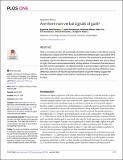Are there non-verbal signals of guilt?
Abstract
Guilt is a complex emotion with a potentially important social function of stimulating cooperative behaviours towards and from others, but whether the feeling of guilt is associated with a recognisable pattern of nonverbal behaviour is unknown. We examined the production and perception of guilt in two different studies, with a total of 238 participants with various places of origin. Guilt was induced experimentally, eliciting patterns of movement that were associated with both the participants’ self-reported feelings of guilt and judges’ impressions of their guilt. Guilt was most closely associated with frowning and neck touching. While there were differences between self-reported guilt and perception of guilt the findings suggest that there are consistent patterns that could be considered a non-verbal signal of guilt in humans.
Citation
Julle-Danière , E , Whitehouse , J , Mielke , A , Vrij , A , Gustafsson , E , Micheletta , J & Waller , B M 2020 , ' Are there non-verbal signals of guilt? ' , PLoS ONE , vol. 15 , no. 4 , e0231756 . https://doi.org/10.1371/journal.pone.0231756
Publication
PLoS ONE
Status
Peer reviewed
ISSN
1932-6203Type
Journal article
Description
The studies were funded by a Leverhulme Trust Research Project Grant Cultural variation in the social function and expression of guilt awarded to the seventh and fourth authors (RPG-2016-206) and the Leverhulme Trust Research Project Grant Rethinking complexity in facial communication systems awarded to the sixth author (RPG-2018-334).Collections
Items in the St Andrews Research Repository are protected by copyright, with all rights reserved, unless otherwise indicated.

